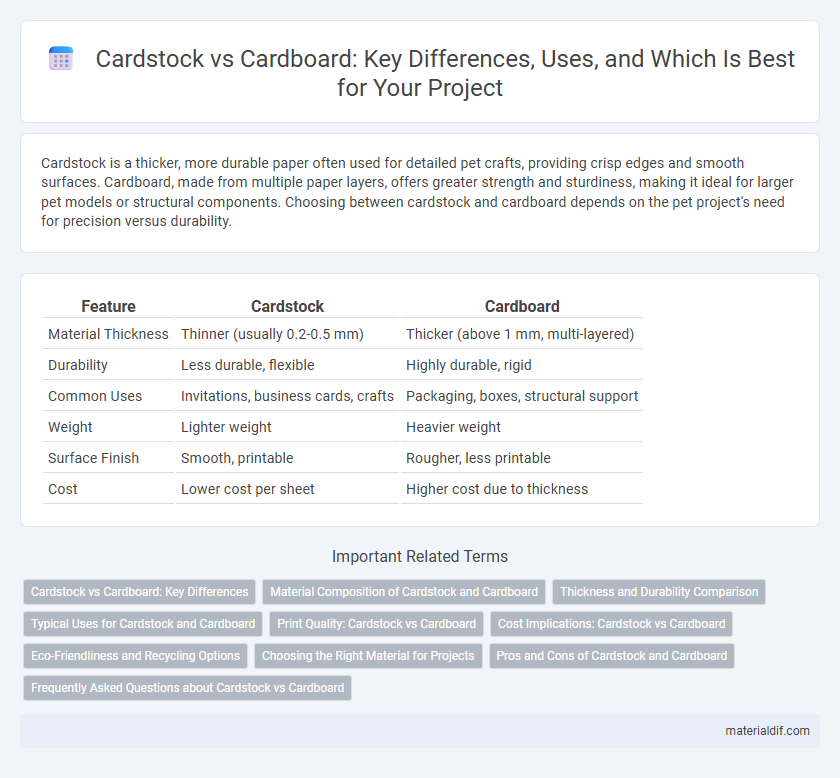Cardstock is a thicker, more durable paper often used for detailed pet crafts, providing crisp edges and smooth surfaces. Cardboard, made from multiple paper layers, offers greater strength and sturdiness, making it ideal for larger pet models or structural components. Choosing between cardstock and cardboard depends on the pet project's need for precision versus durability.
Table of Comparison
| Feature | Cardstock | Cardboard |
|---|---|---|
| Material Thickness | Thinner (usually 0.2-0.5 mm) | Thicker (above 1 mm, multi-layered) |
| Durability | Less durable, flexible | Highly durable, rigid |
| Common Uses | Invitations, business cards, crafts | Packaging, boxes, structural support |
| Weight | Lighter weight | Heavier weight |
| Surface Finish | Smooth, printable | Rougher, less printable |
| Cost | Lower cost per sheet | Higher cost due to thickness |
Cardstock vs Cardboard: Key Differences
Cardstock and cardboard differ primarily in thickness, weight, and flexibility, with cardstock being thinner, lighter, and more pliable, ideal for crafting and printing projects. Cardboard is thicker, sturdier, and more rigid, commonly used in packaging and shipping for its durability and strength. Understanding these key differences helps determine the appropriate material choice based on project requirements and desired durability.
Material Composition of Cardstock and Cardboard
Cardstock consists of thick, durable paper made primarily from cellulose fibers, often coated or treated for added rigidity and smoothness, making it ideal for printing and crafting. Cardboard is a heavier, more rigid material composed of multiple layers of paper pulp or corrugated fiberboard, designed for structural support and packaging. The primary composition difference lies in cardstock's single-layer, dense paper structure versus cardboard's multi-layered, reinforced construction.
Thickness and Durability Comparison
Cardstock typically ranges from 50 to 110 pounds in weight with a thickness of 0.2 to 0.3 mm, offering moderate rigidity suitable for crafts and invitations. Cardboard is generally thicker, varying from 1 mm up to several millimeters depending on the type, such as corrugated or chipboard, providing superior durability for packaging and structural applications. The increased thickness of cardboard enhances its strength and resistance to bending, making it ideal for shipping and heavy-duty uses compared to the thinner, less durable cardstock.
Typical Uses for Cardstock and Cardboard
Cardstock is commonly used for crafting, scrapbooking, greeting cards, and business cards due to its thickness and smooth surface, which allow for detailed printing and easy cutting. Cardboard, being thicker and more rigid, is typically employed in packaging, shipping boxes, and product displays to provide structural support and protection. Both materials differ in durability and intended function, with cardstock suited for decorative projects and cardboard designed for heavy-duty use.
Print Quality: Cardstock vs Cardboard
Cardstock offers superior print quality compared to cardboard due to its smoother surface and consistent thickness, which allows for crisp, vibrant images and sharp text details. Cardboard's rougher texture and porous structure often result in less precise printing and color absorption, making it less ideal for detailed graphic designs. For projects requiring high-resolution prints, cardstock remains the preferred material over cardboard.
Cost Implications: Cardstock vs Cardboard
Cardstock generally incurs higher costs per sheet compared to cardboard due to its finer quality and thinner weight, making it ideal for detailed craft projects and invitations. Cardboard, being thicker and bulkier, is more cost-effective for packaging and shipping as it requires less processing and can be produced in larger sheets at lower prices. Businesses often weigh these cost differences based on the project scale and durability requirements, choosing cardstock for premium presentation and cardboard for economical bulk applications.
Eco-Friendliness and Recycling Options
Cardstock is a thick, durable paper that is widely recyclable and often made from sustainably sourced materials, making it a more eco-friendly choice for lightweight projects. Cardboard, typically thicker and composed of multiple layers, is also recyclable but can vary in environmental impact depending on its production process and coating. Both materials support recycling programs, but cardstock's simpler composition often results in easier recycling and reduced environmental footprint.
Choosing the Right Material for Projects
Cardstock offers a smooth, sturdy surface ideal for detailed printing and crafting, making it perfect for invitations, greeting cards, and scrapbooking. Cardboard, typically thicker and more rigid, provides enhanced durability and is better suited for packaging, model making, and structural projects where strength is essential. Selecting between cardstock and cardboard depends on the balance of flexibility, print quality, and strength required for your specific project.
Pros and Cons of Cardstock and Cardboard
Cardstock offers a smooth finish and is ideal for detailed printing, making it perfect for invitations and crafts, but it can be less durable and prone to bending compared to cardboard. Cardboard provides superior strength and rigidity, suitable for packaging and structural uses, though it may lack the refined surface quality needed for precise graphic designs. Choosing between cardstock and cardboard depends on balancing the need for visual appeal against the requirement for durability and support.
Frequently Asked Questions about Cardstock vs Cardboard
Cardstock is a thick, sturdy paper commonly used for crafting, invitations, and business cards, typically ranging from 50 to 110 lb weight, whereas cardboard is a heavier, more rigid material often used for packaging and shipping boxes, made from multiple layers of paper fibers. Frequently asked questions about cardstock versus cardboard include their differences in thickness, flexibility, and ideal applications, with cardstock being smoother and easier to cut or fold for creative projects. Users often inquire about environmental impact, recyclability, and cost-effectiveness, with both materials being recyclable but cardboard generally more economical for bulk packaging needs.
Cardstock vs Cardboard Infographic

 materialdif.com
materialdif.com